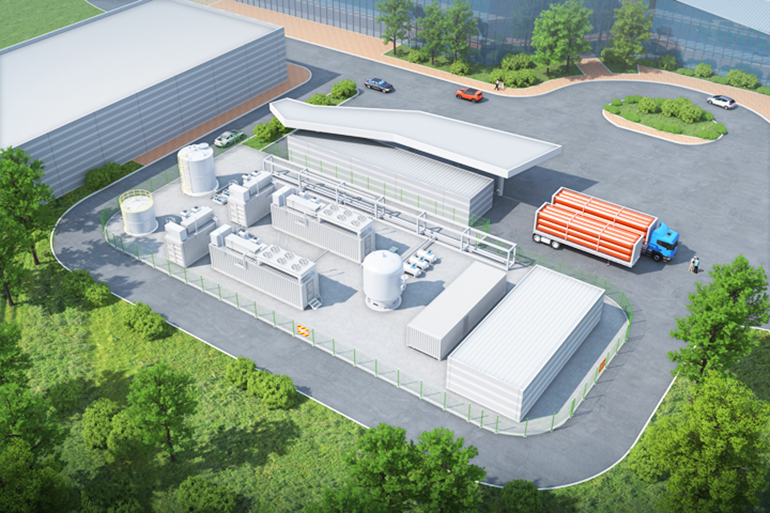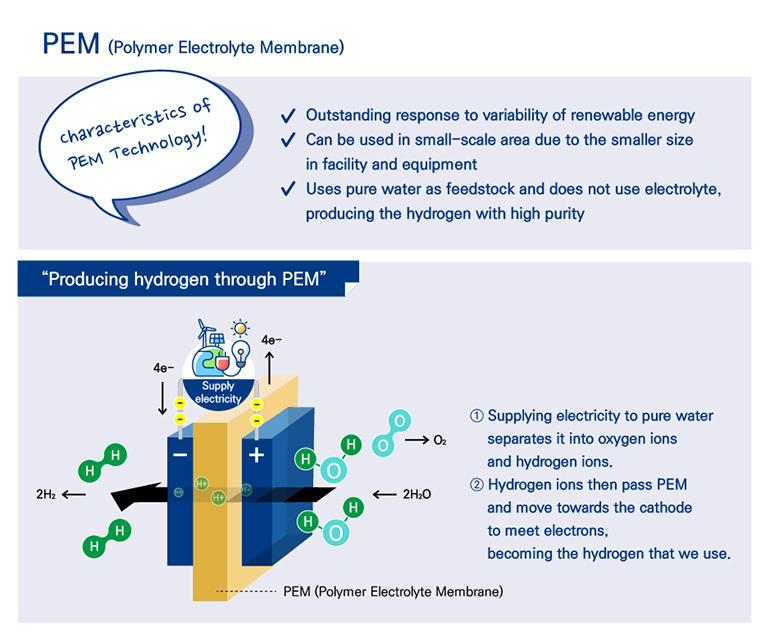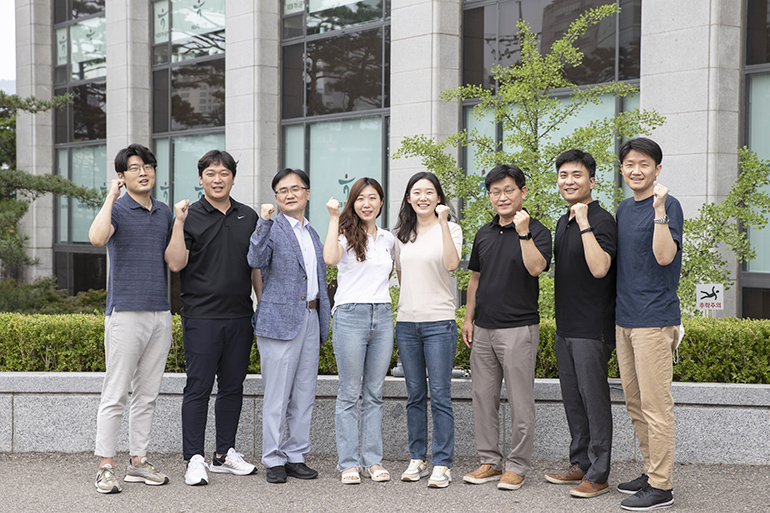
Latest News
- Hyundai E&C Becomes Key Player in the Nuclear Decommissioning Market
- Hyundai E&C Accelerates Global Nuclear Expansion into the U.S. Nuclear Market
- Hyundai E&C Shifts into High Gear to Enter Nordic Large-Scale Nuclear Market
- Hyundai E&C Strengthens Korea-Japan Cooperation in Energy Transition and New Growth Businesses
- Hyundai E&C Signals Green Light for Large-Scale Nuclear Power Plant Business in Europe
[Carbon Neutrality Technology #1] The clean hydrogen technology of Hyundai E&C in accelerating carbon neutrality towards a ‘Fossil Fuel-Free Future’

[ Hydrogen is the first element of the periodic table and the lightest element in nature. The element, which accounts for about 75% of the normal matter of the universe and 90% of all atoms in the universe, is gaining much attention as a very special energy source that can save the planet. ]
It is easy to frequently witness extreme weather such as heat waves or heavy rainfall around the world. Scientists point to carbon dioxide as the cause of abnormal temperatures and climate disasters. This is the background in which ‘carbon neutrality*’ emerged as a crucial issue for the survival of mankind. Countries across the world are making efforts beyond reducing CO₂ levels and declaring ‘net zero,’ which aims to cut greenhouse gas emissions to zero by not emitting any carbon or capturing carbon, by 2050. This is also the reason why countries are turning to renewable energy generated naturally through sources like solar or wind instead of generating energy by burning fossil fuels such as coal, oil, and natural gas.
*Carbon neutrality: a state of net-zero carbon dioxide emissions generated by economic activities.
Clean Energy Hydrogen, Saving the Planet – The Optimal Solution for Storing and Transporting Renewable Energy
One would wonder if there’s anything better than energy generated naturally, but there are limitations to renewable energy. Solar energy can only be supplied during the time period between sunrise and sunset. Solar energy output also drastically drops in the evening or under cloudy weather. Wind power is difficult to obtain on days without wind. Not enough electricity is an issue, but excessive electricity production by renewable energy is also a problem. If energy production exceeds consumption, it causes the electrical frequency to become unstable and makes generators stop running (in other words, blackouts). Excess electricity can be stored in Energy Storage Systems (ESS), but they are heavy, costly, and can lead to natural loss.
The answer to the question, “is there an eco-friendly new energy source that allows to store excess electricity or use when there is not enough electricity without having to worry about running out?” is in ‘hydrogen.’ Hydrogen is the key to overcoming the limitations of renewable energy. It is also an element with the lightest and the simplest structure in the world. We can store excess power as hydrogen and use it as electric energy by sparking a chemical reaction with oxygen when we need it. This process only produces water and emits no greenhouse gases.
Hydrogen is easy to store and transport. It can be stored in a high-pressure tank and when it is liquefied by cooling it to below -253°C, its volume is reduced to 1/800. It can be transported via tank or pipeline and there is low energy loss even during long-distance transportation for import or export. These are the reasons why the ‘hydrogen economy,’ an economy that relies on hydrogen, is becoming the ideal energy paradigm.
Hyundai E&C Takes the First Step as ‘First Mover’ into Hydrogen Society – Establishing Korea’s First-ever Water Electrolysis-based Green Hydrogen Production Base
A hydrogen economy is comprised of the three value chains of production, storage and transportation, and utilization. Hyundai E&C believes that hydrogen, the key energy source in a carbon-neutral future, will be a new opportunity in future energy and plant markets. The company is therefore accelerating efforts to secure technology across all steps from production to utilization of hydrogen. Hyundai E&C especially is driven to secure key technologies in water electrolysis-based hydrogen production and core technologies in hydrogen storage and transportation as well as strengthening its capability in *Front End Engineering Design (FEED) for hydrogen plants.
*FEED: Plant engineering is largely comprised of steps as follows: conceptual design → basic design → FEED → detailed design → procurement → construction → trial operation → maintenance. Conceptual design is about defining the concept of the project and establishing an initial plan. The basic design is about drawing a sketch of the plant and establishing the direction of the design. The important step is FEED. FEED lays the basic framework of the construction before the engineering, procurement, and construction (EPC) contract. It defines the criteria for calculating construction estimation and it is a crucial step in laying the foundation for construction. FEED requires in-depth project experience and a deep understanding of the process, meaning that securing a FEED contract will allow the company an advantage in EPC contract as well.
Hydrogen can be categorized by the production process into ‘byproduct hydrogen,’ which is the byproduct of the petrochemical industry, extracted hydrogen (reformed hydrogen) from natural gas, and ‘water electrolysis hydrogen’ as excess renewable energy produced by electrolyzing water. Hydrogen can also be classified into grey hydrogen, blue hydrogen, and green hydrogen according to whether the production process generates carbon dioxide.

Grey hydrogen refers to the byproduct naturally created when separating and refining oil, cokes, and naphtha along with hydrogen separated and extracted from natural gas using a method called ‘steam reforming*.’ These types of hydrogen have been used for a long time in several industries for refining petrochemicals or cleaning semiconductor wafers. It has the advantage of being relatively cheap but has a fatal downside of contributing to global warming because producing 1kg of hydrogen by natural gas reforming generates about 10kg of carbon dioxide.
*Steam reforming: a method for producing hydrogen by reaction of high-temperature and high-pressure steam and natural gas with a nickel catalyst.
The method of production for blue hydrogen is the same as for grey hydrogen. The difference is whether carbon dioxide generated in the process is captured to be stored and used. Blue hydrogen is considered the most realistic alternative because it can drastically reduce carbon emissions in today’s reality where it is impossible to completely cut off using fossil fuels.
Green hydrogen can be obtained through water electrolysis technology (water electrolysis hydrogen). Water electrolysis technology produces hydrogen by splitting water with the electricity gained from renewable energy. This process does not emit greenhouse gases and therefore is called the ‘ultimate energy source’ in achieving carbon neutrality. Currently, there is not enough infrastructure for green hydrogen production in the world and more effort must be made to ensure economic feasibility. But it is the ultimate direction in which we must pursue.
Blue hydrogen and green hydrogen are both called ‘clean hydrogen’ because they generate zero or significantly less carbon dioxide in the production process. Hyundai E&C established a roadmap to become the ‘First Mover’ toward a hydrogen society with a strong belief that securing the necessary technology early on is crucial. Hyundai E&C, as an EPC company and a developer, aims to strengthen its capabilities for blue hydrogen in the short term and for green hydrogen in the long term.
Hyundai E&C was awarded a hydrogen production plant based on electrolysis from the Ministry of Trade, Industry and Energy on June 2 was also a part of Hyundai E&C’s roadmap. Hyundai E&C, in consortium with Jeollabuk-do, Buan-gun, Jeonbuk Technopark, and Techcross Water & Energy Inc., will construct an electrolysis plant that produces more than 1 ton of hydrogen a day as well as stores and transports hydrogen. The production base will be built at the renewable energy complex located in Buan, Jeollabuk-do, by May 2024.

[ The water electrolysis-based hydrogen production base that will be built in Buan, Jeollabuk-do, is Korea’s first-ever commercial clean hydrogen production base. Image is an aerial view. ]
The hydrogen production plant that will be constructed in Buan has significance in that it will be the first commercial-purpose clean hydrogen production base in Korea. There have been research facilities related to water electrolysis, but it will be the first-ever production base in Korea for commercial purposes. Hyundai E&C will be responsible for the basic and detailed design, procurement of key equipment as well as the construction of the hydrogen plant including water electrolysis facilities, power supply facilities, and shipment facilities to transport hydrogen via tube trailers (trucks that transport hydrogen). Hydrogen produced at this plant will be used for hydrogen mobility in connection to hydrogen stations. A water electrolysis expert at Hyundai E&C said, “although it is not a plant of a very large capacity, it is the largest in Korea and it will be operated long-term for 5 years” and explained that “this project will become the foundation for future mega hydrogen plants that will be built at home and abroad.”
Hydrogen Economy Led by Hyundai E&C – High Purity Hydrogen Production… Preparing for Future Mega Hydrogen Projects
Water electrolysis is the key technology in the mass production of clean hydrogen. Water electrolysis technology can be categorized into Alkaline Electrolysis Cell (AEC) and Polymer Electrolyte Membrane Electrolysis Cell (PEM)* depending on whether it moves hydrogen ion (H+) or hydroxyl ion (OH-) and the electrolyte that is used.
*Polymer Electrolyte Membrane Electrolysis Cell is also called the Proton Exchange Membrane Electrolysis Cell.
AEC is a technology that has been developed more than 50 years ago. It electrolyzes water using alkaline electrolyte and has the benefit of low facility investment costs. However, the size of the facility is big, which means it requires a large area of land. And the method consumes a lot of electricity, while the purity of the hydrogen generated is low. The limitation of AEC is that its response speed is slow for it to respond to the variability of renewable energy, which fluctuates depending on weather conditions. For example, water electrolysis equipment must quickly operate when the wind blows at a wind farm, but AEC has a technical limitation that takes a long time to turn on and off.

PEM, on the other hand, is a technology that improves the several weaknesses of AEC and its coupling with renewable energy is remarkable. The technology can produce hydrogen in a timely manner according to the timing and cycle of the production of renewable energy. It can also adjust the output from 0% to 100%. The size of the stack, a core component of water electrolysis technology, is smaller than that of AEC, and therefore, the production facility can be made smaller. PEM extracts hydrogen from water using a platinum-based catalyst and polymer electrolyte membrane. Unlike AEC, it doesn’t use an electrolyte. And because it electrolyzes pure water and moves positive ions through a separation membrane, the purity of the hydrogen can be high. Although costs are high in maintaining a PEM facility because polymer electrolyte and platinum-based catalysts are expensive, it is expected that it will account for a high proportion of the water electrolysis market by 2025 because it can produce high-purity hydrogen. The water electrolysis-based hydrogen plant Hyundai E&C will build for the first time in Korea and will apply PEM technology.
Solid Oxide Electrolysis Cell (SOEC) and Anion Exchange Membrane Electrolysis (AEM) are being explored as next-generation water electrolysis technologies, but they are not a good fit for renewable energy or will have to go through several demonstrations until they become commercialized. An official at the Hydrogen Energy Research Team of Hyundai E&C’s Technology Research Center in charge of incubating the hydrogen economy value chain said, “PEM of strong performance will lead the global water electrolysis equipment market” and added, “establishing the PEM-based hydrogen production base in Buan, Jeollabuk-do will lay the foundation in making Korea and Hyundai E&C into a leader in the hydrogen economy.”
Hydrogen society is the present, not a distant future. Many experts around the world predict that by 2050, hydrogen will account for 20% of all energy around the globe. It is an outlook that predicts the hydrogen business will grow as much as natural gas (20%) accounts for today.
Hyundai E&C is actively partnering with specialized companies in order to lead the global water electrolysis hydrogen plant market that is expected to grow to a cumulative KRW 1700 trillion by 2030. It is also dedicated to securing capabilities including the basic design of GW-grade large-scale water electrolysis hydrogen plant and the production of clean hydrogen using nuclear energy. Hyundai E&C Hydrogen Energy Research Team explained, “mega projects for hydrogen plants will begin in earnest in 2025” and noted, “the year 2022 is a critical time to prepare for the war over winning project contracts.” The team also expressed determination by saying, “like how Japanese companies lead the LNG business, Hyundai E&C will become a global top tier company in the hydrogen industry.”
Mini Interview | Hydrogen Energy Research Team in Technology Research Center
“We Will Lead the Incubation of the Hydrogen Economy Value Chains of Hyundai E&C”

Q What are the key responsibilities of Hydrogen Energy Research Team at Hyundai E&C’s Technology Research Center?
The Hydrogen Energy Research Team oversees the incubation of Hyundai E&C’s hydrogen economy value chain. We are dedicated to preemptively securing core technologies such as water electrolysis, hydrogen liquefaction, liquid organic hydrogen carriers (LOHC), and ammonia, which are promising products in the future field of hydrogen production, storage, and transportation as well as creating new business opportunities. It is also our team’s role to develop technologies for not only green hydrogen in connection to renewable energy but also technologies for hydrogen production in connection to nuclear energy.
Q Hyundai E&C will establish a water electrolysis-based hydrogen production plant for the first time in Korea. What significance or meaning does this plant that will be built in Buan, Jeollabuk-do have?
We are proud to be selected to establish Korea’s first-ever clean hydrogen production plant. With this project, Hyundai E&C has become the first construction company in Korea to implement a basic and detailed design of a hydrogen plant, lead procurement of key materials, and conduct the construction of the facility. The water electrolysis-based hydrogen plant that will be built in Buan, Jeollabuk-do is meaningful in that Hyundai E&C will have the opportunity to ensure core capability such as FEED as well as the experience of operating such a facility for five years after completion. The experience and knowhow we gain through the project will be a crucial foundation in pioneering the global GW-grade hydrogen plant market that is predicted to grow quickly.
Q Hyundai E&C is strengthening its capability in becoming an all-around ‘global top tier’ company in hydrogen economy from production and storage to transportation and utilization. Could you briefly explain each value chain, please?
Hyundai E&C has engaged in various activities aside from the activities explained before to fully prepare for the transition toward a hydrogen society. As a key example, there is the FEED contract for SK E&S’s Boryeong clean hydrogen plant project. It is a project on FEED engineering for the construction of a hydrogen liquefaction plant and ancillary facilities that can produce 250,000 tons of eco-friendly blue hydrogen per year. We aim to win an EPC contract and take part in follow-up projects. We are also implementing fuel cell projects under the leadership of Hyundai E&C’s Development & Investment Business Division in the field of hydrogen utilization.
Q Hyundai E&C has taken a big step into becoming a ‘First Mover’ into a hydrogen society. What is the future vision of Hyundai E&C from an expert’s point of view?
We anticipate there will be large-scale hydrogen plant projects across the Middle East, North Africa, South America, and Australia. Currently, global leading EPC companies are aiming to take part in large-scale hydrogen projects by conducting conceptual design and basic design. Korean companies are also actively jumping into hydrogen plant projects. As an EPC company, Hyundai E&C is strengthening its hydrogen-related value chain to ensure unrivaled competitiveness. Our objective is to become the top-tier company in the global hydrogen plant market by 2030. With our clear objective of becoming the ‘First Mover in hydrogen society,’ the Hydrogen Energy Research Team feels the heavy burden of achieving our goal.
▶ Although it is desirable to produce 100% green hydrogen only with water electrolysis technology, there is a long way to go to improve in terms of high cost and total output. Moreover, in our reality where it is almost impossible to completely cease the use of fossil fuels, we must pay close attention to the potential of blue hydrogen. [Hyundai E&C’s Carbon Neutrality Technology #2] will cover carbon capture, utilization, and storage (CCUS) technology, which is key to producing blue hydrogen. |

